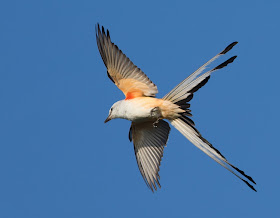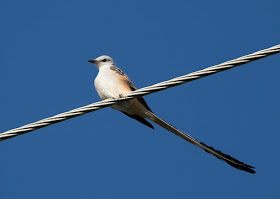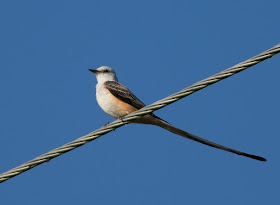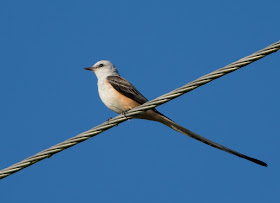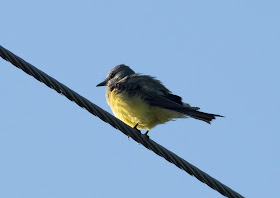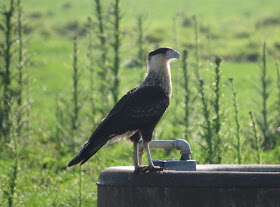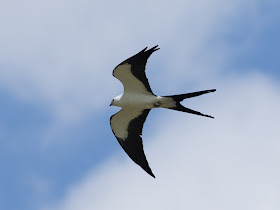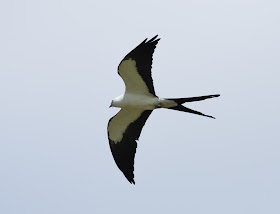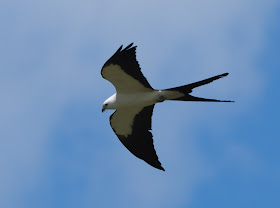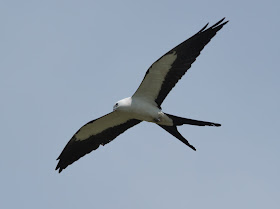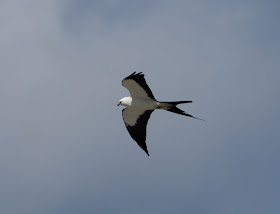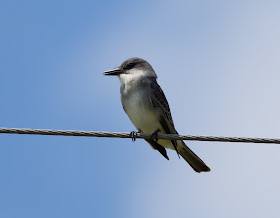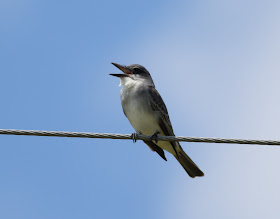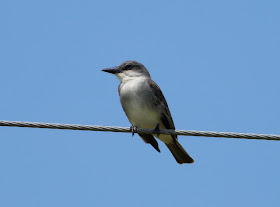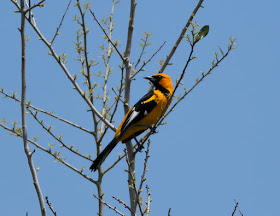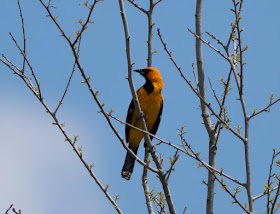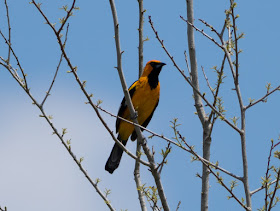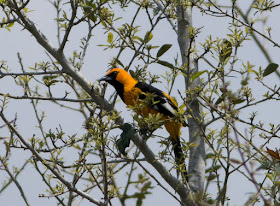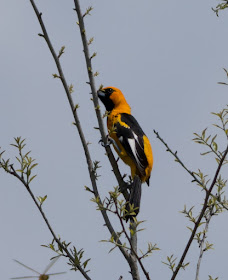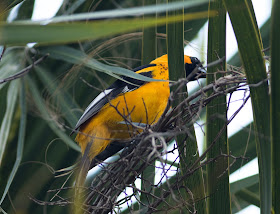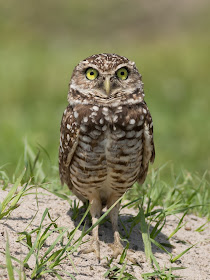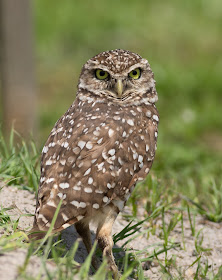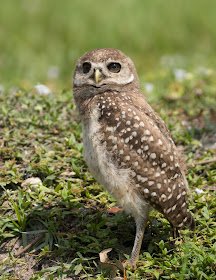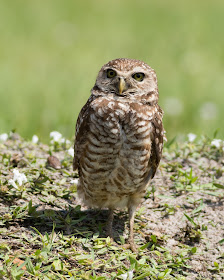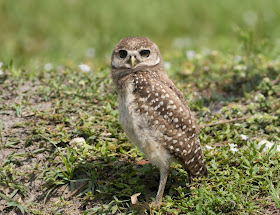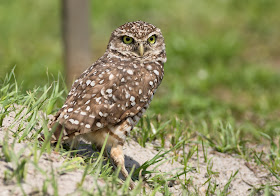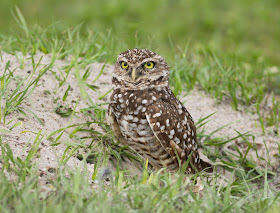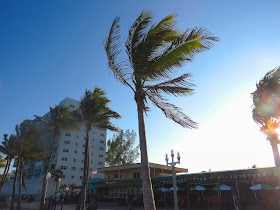Day 5 - Friday 1st April 2016
The journey down to Miami had
been one of the days I had been looking forward to the most on our trip. Packed
full of the promises of such charismatic species as Scissor-tailed Flycatchers,
Spot-breasted Orioles, Burrowing Owls and further sightings of the majestic
Swallow-tailed Kites, this was most certainly a day not to be missed. With the
sun shining once again against the backdrop of the brilliant powder blue sky,
we were soon well on our way to our first point of call – Stormwater Treatment
Area 5/6 and the surrounding roads.
Before we had even reached our
destination, Alex had brought the car to a screeching halt – and for good
reason – a Scissor-tailed Flycatcher was perched on the wires right above us!
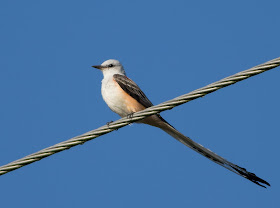 |
| Scissor-tailed Flycatcher |
Parking on a nearby side road and heading back, we were soon enjoying
absolutely breath-taking views of this incredible species, our first bird now
joined by several other chattering individuals.
With their spectacular long
tails and gorgeous salmon toned plumage, Scissor-tailed Flycatcher was one of the
main targets of the whole trip for both of us, and we were slightly concerned
that the overwintering Florida population may have already moved on, with just
a handful of birds remaining at Lucky Hammock Reserve and L1 Dike Road near
Stormwater Treatment Area 5/6. Fortunately we struck it lucky, and these
beautiful flycatchers were one of the firm highlights of the trip.
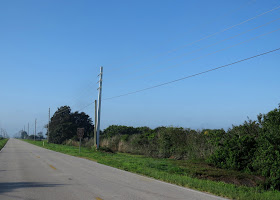 |
| The wires along the roads in the area are renowned for Flycatchers and Kingbirds |
Due to being transfixed on the
Scissor-tailed Flycatchers, it took an age for us to notice a Kingbird was
congregating with them, its shorter tail and lemon yellow belly distinguishing
itself from the rest of the flock and sending us in to panic mode. Tropical or
Western? Either would be a new bird for us, but with Western Kingbirds also
residing in California (a place we were hoping to visit on a future trip to
America) Tropical was the species to get.
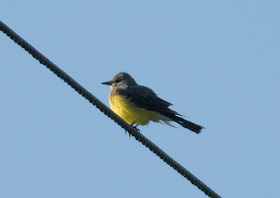 |
| Western Kingbird? |
Taking a series of photos to
aid with identification later, our focus soon shifted back to the flycatchers –
perhaps we should have taken a few more field notes! Studying the photos it wasn’t
immediately obvious which species we had seen, the length of the bill was hard
to determine and the breast was obscured due to the bird facing away. The tail,
another key feature for identification, was also extremely tatty due to moult
and wasn’t too much help to us. Studying the photos and Alex’s video (which
displayed the bird in motion), we eventually came to the conclusion that it was
a Western Kingbird – the bill looking much shorter than would be expected for a
Tropical Kingbird and the tail displaying some white edges as also familiar in
this species.
With the Scissor-tailed
Flycatchers departing, we continued on to L1 Dike Road, spotting another
flycatcher perching on the wires as we neared the entrance. Hoping to locate
the pair of Tropical Kingbirds that had been residing in the area, we sadly
drew a blank on that front, but over 15 Burrowing Owls (though extremely
distant) were our next new birds of the trip while further Crested Caracaras
and an unexpected American Barn Owl (now split as a separate species) were additional highlights.
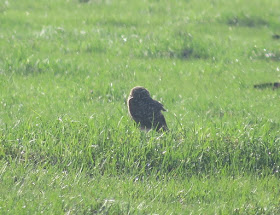 |
| Record shot of the Burrowing Owl! |
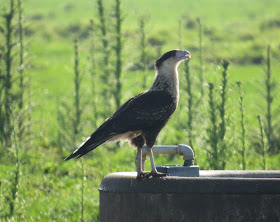 |
| Juvenile Crested Caracara |
Driving around to the front
entrance of Stormwater Treatment Area 5/6 also provided us with our best photo
opportunities of the whole trip in terms of photographing the beautiful
Swallow-tailed Kites.
 |
| Swallow-tailed Kite |
One stunning individual patrolled up and down the side of
the track, hunting for small reptiles and birds and providing prolonged up
close and personal views of this gorgeous raptor.
Indeed, the Kite was still
there when we left an hour later, and powering after it in the car and stopping
at intervals to intercept its flight path with the camera as it swooped past resulted
in some particularly pleasing photos.
On paper Stormwater Treatment
Area 5/6 looked to be an extremely productive location, with a number of new
species for us including both Black-bellied and Fulvous Whistling-ducks as well
as Sedge Wrens. However, in reality it seemed to be devoid of any large masses
of avian fauna. With the relentless heat beating down, the best we could manage
were Common Gallinules and American Coots, with three Black-necked Stilts and a
Roseate Spoonbill breaking the monotony. Cutting our losses and with me
stupidly leaving my hat in the car, we trudged back disappointed, no
Whistling-ducks in sight and the nearest pools where they could potentially be
miles and miles down the track – unthinkable in this heat and without vehicle access (it
brought back horrible memories of a similar Red-knobbed Coot treck in Southern
Spain in 30 degree heat!)
 |
| Queen Butterfly - a highlight of Stormwater Treatment Area 5/6 (Photo by Alex Jones) |
With the rest of the afternoon
ahead of us, we decided to make our way down to our next port of call – Markham
Park near Miami for an introduced exotic in the form of the attractive Spot-breasted
Orioles. With our original location of Vista Park beach not having any records
recently on e-bird and with up to three birds seen regularly near the car park
at Markham, this was more likely to result in success on the Oriole front.
Whizzing down the Josie Billie
Highway after leaving the Stormwater Treatment Area, I spotted a grey bird
perched on the wires that looked suspiciously like a Gray Kingbird.
 |
| Gray Kingbird |
This was
another species we had hoped to see along L1 Dike Road but had failed to
connect with, and with birds moving up in to Florida from the middle of April
onwards, I had feared we may have been a touch too early to catch up with any.
Making Alex turn the car around and head back, we were both astounded when it
did in fact turn out to be an extremely smart looking Gray Kingbird (Alex was convinced
I’d messed up and thought it would just be another Catbird or Mockingbird) and
we were able to pull up alongside it and watch at leisure what turned out to be
our only individual of the trip.
Arriving at Markham Park, I
immediately clocked on to a pair of birders complete with optics heading back
to the car park. Knowing a rough location for the Orioles but with no definite
gen, we quickly learned the duo had been watching one 5 minutes ago just a
short walk down the path at the end of the dog exercise park. Rushing over, it
became apparent the oriole had disappeared, and it took a further half an hour
before I finally relocated it in a tree inside the dog park enclosure.
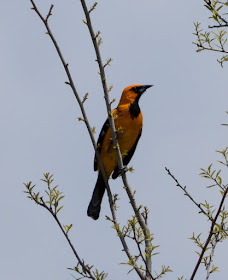 |
| Spot-breasted Oriole |
With a
beautiful tropical orange breast complete with a jet black speckled necklace
across the throat, there was no denying the Spot-breasted Oriole added a touch
of the exotic to the Miami suburbs.
Originating from Central America,
Spot-breasted Orioles are now accepted by the ABA as a countable introduced
species in Miami, and it was great to see this often sought after and elusive
species so well.
Our next stop was Brian Piccolo
Sports Park – a huge outdoor sports centre renowned in the birding world for
its nesting Burrowing Owls. Despite seeing them earlier on in the day, we were
both keen to visit this excellent location, as the Burrowing Owls here are
known to get ridiculously close! Pulling up and parking alongside the baseball
fields where the Burrowing Owls nested, the burrows were immediately obvious,
taped off to prevent disturbance and with some even sporting wooden perches for
the owls to rest on.
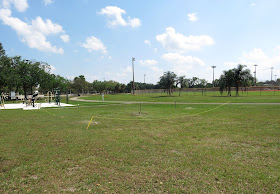 |
| Burrowing Owl nest! |
Remarkably, the first burrow we checked was occupied, a
pair of smart adult birds standing guard just feet away from us while a fluffy
owlet crouched amongst them!
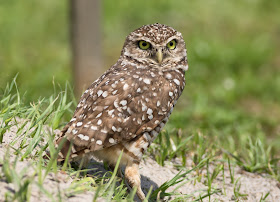 |
| Burrowing Owl |
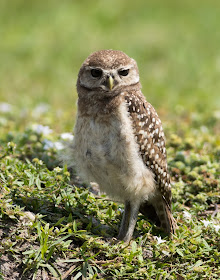 |
| Baby Burrowing Owl! |
Clearly well used to human
presence, the owls were completely unconcerned as we watched on, staring up at
the sky intently every time a plane passed overhead and keeping a constant
watch out for predators.
It is always a fantastic experience to get such
incredible views of a bird, and we were able to take in the beautiful bright
yellow patterns of their striking eyes as they stared at us, the young owlet’s
jet black irises equally as piercing. An unforgettable experience – so much more satisfying and memorable
than the distant views we’d had earlier that morning.
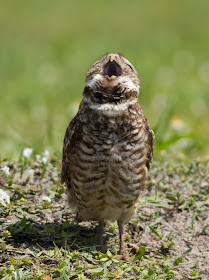 |
| One tired Burrowing Owl... |
Tearing ourselves away from
the owls, we made our way over to our final destination of the day - Topeekeegee
Yugnee Country Park and the place where a Neotropic Cormorant had been calling
home for the past couple of months. Despite scanning the large lake we failed
to locate this Florida rarity, but an unexpected lifer was added nonetheless in
the form of Muscovy Duck. Not realising at the time, there is an established
feral population of Muscovy Ducks in Miami which, like the Spot-breasted
Orioles, are accepted and fully countable by the ABA. Despite the fact that we
saw many dotted around the suburbs of Florida’s capital, we both failed to get
any photos of these dark coloured (and rather ugly!) ducks, including a pair
with a number of adorable chicks in tow a few days later.
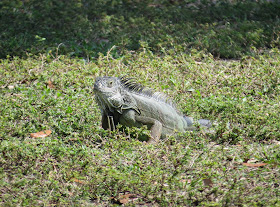 |
| Common Green Iguana at Topeekeegee Yugnee Country Park |
Staying just outside of Miami
in the outskirts of Hollywood for the next two nights, we checked in to our
bright and airy beachside boutique apartment before checking out the beautiful
palm tree lined beach boulevard a mere 2 minute walk away – the perfect way to
relax after a busy few days birding!
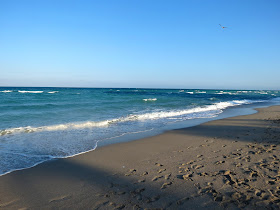 |
| The beaches around Miami are world famous and for good reason - they certainly didn’t disappoint! |
 |
| Brown Pelican |
Watching a flock of Brown
Pelicans cruise effortlessly over the waves as the last hints of orange glow
from the sun disappeared below the horizon, we waited well over an hour for our
dinner to arrive (and it was even the wrong order, cold and tasteless when it
arrived!) but it was great to sit back and relax in preparation for the next
day and a part of the trip I had been looking forward to for months –finally
the time had come to pay a visit to the Smooth-billed Anis!
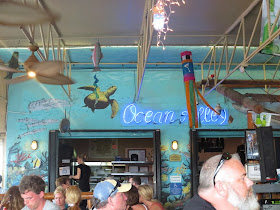 |
| The colourful walls made up for the dire service! |
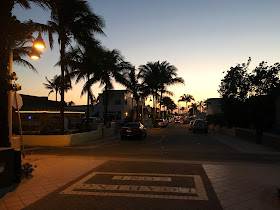 |
| Sunset in Miami |

















